Do you often find yourself reaching for another snack shortly after eating, or experience inexplicable slumps in energy throughout your day? These common complaints might point to a less obvious culprit in your diet: hidden sugar. Far beyond the obvious sweets, added sugars lurk in a surprising array of everyday foods, silently impacting your metabolism, mood, and overall health. Understanding how to spot these covert sweeteners and recognize the signs of their overconsumption is the first step toward reclaiming stable energy and lasting satiety.

The Sneaky Truth About Hidden Sugar
Sugar is not just the white granulated variety you spoon into your coffee. It comes in many forms, often disguised under various names on food labels, and is added to packaged foods not only for sweetness but also for texture and as a preservative. Many foods marketed as “healthy” or “low-fat” can contain significant amounts of hidden sugars to compensate for flavor loss or enhance palatability. The American Heart Association recommends limiting added sugar to about 6 teaspoons (25 grams) for women and 9 teaspoons (36 grams) for men daily, yet the average American consumes far more. This overconsumption can lead to a range of health issues, from obesity and type 2 diabetes to heart disease and cognitive decline.
Common sources of hidden sugar include:
- Condiments and sauces: Ketchup, barbecue sauce, salad dressings, and pasta sauces.
- Breakfast foods: Many cereals, granola, and flavored yogurts.
- Drinks: Sports drinks, flavored coffees, iced teas, and fruit juices (even 100% juice can be high in natural sugars without the fiber of whole fruit).
- Snacks: Protein bars, cereal bars, and even canned fruits in syrup.
To identify hidden sugars, always check the nutrition label for “added sugars” and scrutinize the ingredient list. Ingredients are listed in descending order by weight, so if sugar or one of its many aliases appears near the top, the product is likely high in added sugar. Be aware of common sugar names like high-fructose corn syrup, agave nectar, cane sugar, dextrose, fructose, glucose, maltose, sucrose, and molasses.

7 Tell-Tale Signs You Might Be Eating Too Much Hidden Sugar
Recognizing these signs can help you identify if hidden sugar is derailing your health goals and well-being.
1. Persistent Cravings and Increased Hunger
If you constantly feel hungry, even after eating, or find yourself battling intense cravings for sweet or starchy foods, hidden sugar might be the culprit. Sugary foods cause a rapid spike in blood glucose, followed by a sharp drop. This blood sugar roller coaster triggers the body to signal hunger again, creating a vicious cycle. Studies show a correlation between higher sugar consumption at breakfast and increased hunger sensations before lunch, leading to greater food intake. Furthermore, sugar activates the brain’s reward system, releasing dopamine and encouraging a continuous desire for more sugary treats.
2. Frequent Energy Crashes and Chronic Fatigue
While a sugary snack might offer an initial burst of energy, this “sugar rush” is inevitably followed by a “crash” that leaves you feeling more tired than before. The body quickly breaks down simple sugars, causing blood sugar levels to rise rapidly and then fall sharply as insulin is released to regulate them. These dramatic fluctuations can leave you feeling sluggish, lethargic, and perpetually fatigued, even after a full night’s sleep. Over time, high sugar intake can even hinder the body’s ability to produce energy efficiently.
3. Unexplained Weight Gain, Especially Around the Midsection
Sugary foods are often calorie-dense but nutritionally poor, leading to the consumption of “empty calories” that don’t provide lasting fullness. This lack of satiety can result in overeating and subsequent weight gain. Particularly, excessive sugar intake, especially fructose, is linked to increased fat accumulation, often observed as rapid weight gain around the abdomen (visceral fat). This visceral fat releases inflammatory proteins and hormones, contributing to chronic inflammation.
4. Mood Swings, Irritability, and Anxiety
The same blood sugar fluctuations that cause energy crashes can profoundly impact your mood. The rapid rise and fall of blood glucose levels can lead to irritability, heightened anxiety, and even symptoms of depression. Research suggests a link between high-sugar diets and an increased risk of mood disorders. If you find yourself experiencing dramatic shifts in emotions, your sugar intake might be a contributing factor.
5. Skin Problems: Acne and Premature Aging
What you eat directly affects your skin. High sugar intake can trigger inflammation in the body. When blood sugar spikes, it can lead to increased sebum (oil) production and inflammation, contributing to acne breakouts. Furthermore, sugar can damage collagen and elastin, the proteins responsible for maintaining skin elasticity and firmness. This process, known as glycation, can accelerate the formation of wrinkles and lead to sagging skin, making you appear older than your years.
6. Disrupted Sleep Patterns
A diet consistently high in sugar can interfere with your ability to get restful sleep. Consuming sugary foods, particularly in the evening, can cause an energy rush at a time when your body should be winding down. This can lead to restlessness and less deep, restorative sleep. Poor sleep, in turn, can intensify sugar cravings, creating a detrimental cycle that impacts both your sleep quality and dietary choices.
7. Increased Thirst and Frequent Urination
Excess sugar in your bloodstream can prompt your kidneys to work overtime to flush it out, leading to increased urination. This fluid loss can then trigger excessive thirst as your body tries to rehydrate. While occasionally feeling thirsty is normal, persistent thirst accompanied by frequent trips to the bathroom can be a subtle but important sign that your body is struggling to manage high sugar levels and may even indicate a risk of developing type 2 diabetes.

Taking Control of Your Sugar Intake
If you recognize several of these signs, it might be time to take a closer look at your sugar consumption. Reducing hidden sugars in your diet doesn’t mean eliminating all sweetness; it means making conscious, informed choices.
- Read Labels Diligently: Always check the “Added Sugars” line on the Nutrition Facts panel and familiarize yourself with the many names for sugar.
- Opt for Whole Foods: Prioritize unprocessed foods like fresh fruits, vegetables, lean proteins, and whole grains, which naturally contain fiber and nutrients that slow sugar absorption.
- Cook at Home: Preparing your own meals gives you complete control over ingredients, allowing you to avoid hidden sugars common in processed and restaurant foods.
- Choose Unsweetened Beverages: Swap sugary drinks like sodas, sweetened teas, and fruit-flavored drinks for water, sparkling water, or unsweetened coffee and tea. Infuse water with fruit slices for natural flavor.
- Be Wary of “Healthy” Marketing Claims: Labels like “low-fat,” “organic,” or “natural” don’t guarantee low sugar content. Many low-fat products have added sugar to enhance flavor.
- Gradually Reduce Sweetness: If you add sugar to drinks or food, try cutting the amount in half, and continue reducing until your taste buds adjust.
- Snack Smart: Choose snacks without added sugar, such as plain nuts, seeds, fresh fruit, or plain yogurt.
By becoming a sugar detective and making intentional changes, you can alleviate symptoms like constant hunger and energy crashes, paving the way for improved health, stable energy, and a better mood. Small, consistent efforts to reduce hidden sugars can lead to significant positive impacts on your overall well-being.







